
Figure 1. Circa 1830s microscope signed "Victor Chevalier, breveté, quai de l'Horloge 77, Paris". The word "breveté" means "patented".
Victor Chevalier (Louis Victor Chevalier), 1812 – ca. 1870
by Brian Stevenson
last updated January, 2022
To date, a single microscope is known that bears Victor Chevalier's name and address of 77 Quai de l'Horloge, Paris. He was primarily known for manufacturing barometers, including a portable instrument that he patented in 1834. His business was described in 1834, "M. Victor Chevalier also builds all kinds of glass instruments for physics and chemistry, thermometers, manometers for steam engines, hydrometers of all kinds, syphons, Welter tubes, etc.; he manufactures reading, performance and field glasses, dark rooms, light rooms, graphometers, mathematical cassettes, surveyor squares and chains, compasses, levels and all optical instruments".
The known Victor Chevalier microscope is nearly identical to instruments that were made by Vincent Chevalier (1771-1841) (Figure 2). Vincent Chevalier, his son Charles (1804-1859), and grandson Arthur (1830-1874) produced large numbers of microscopes during the 1800s. It is highly likely that the microscope signed by Victor Chevalier was actually produced in the shop of Vincent Chevalier.
Records strongly suggest that Victor Chevalier was a son of Louis Chevalier (full name Jean Louis Joseph Chevalier, lived ca. 1776 - 1848), who was a brother of Vincent Chevalier. During the 1830s, all three men operated optical shops along Quai de' l'Horloge: Louis at number 65, Vincent at number 69, and Victor at number 77. For many decades, that street was home to numerous manufacturers and retailers of optical, scientific, and engineering apparatus.

Figure 1.
Circa 1830s microscope signed "Victor Chevalier, breveté, quai de l'Horloge 77, Paris". The word "breveté" means "patented".
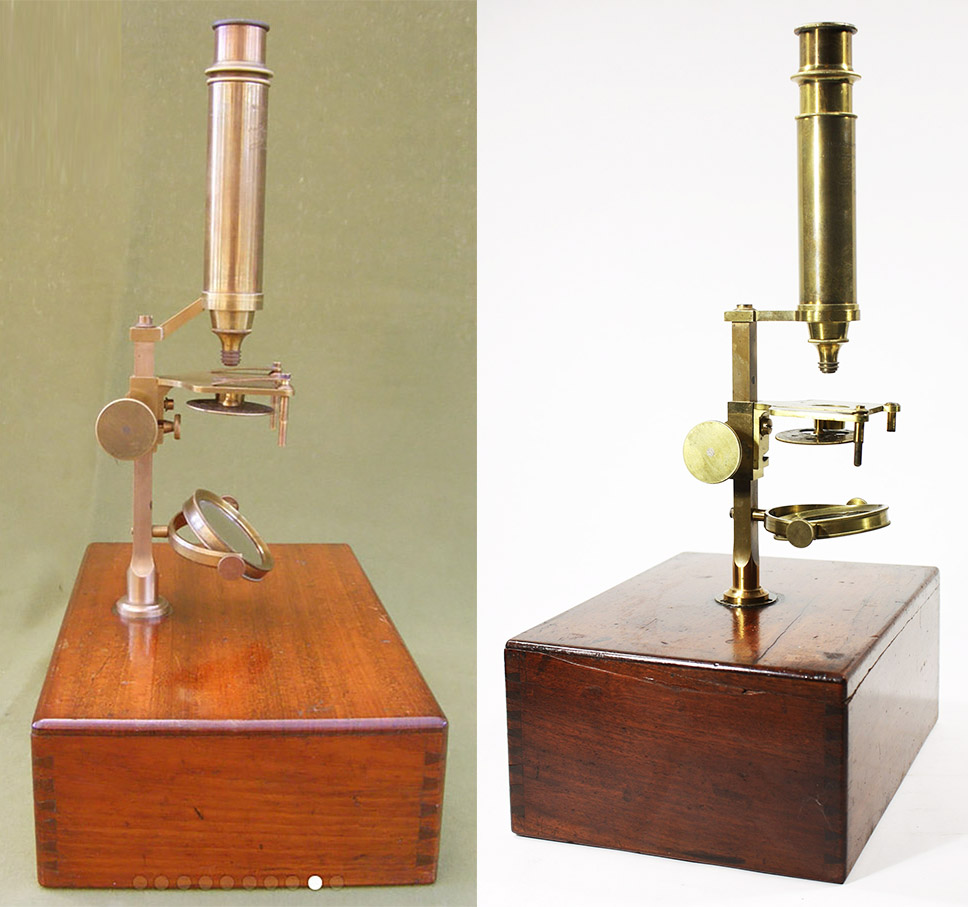
Figure 2.
Two microscopes that are signed by Vincent Chevalier. Vincent was well known for his microscopes.

Figure 3.
Circa 1830s trade label from Victor Chevalier. He offered to produce daguerreotype portraitsm and sold optical, mathematical, and physical instruments. This label is on the reverse of the daguerreotype shown below in Figure 11. Adapted for nonprofit, educational purposes from an internet auction site.
Comparisons of Parisian government records led to the conclusion that Louis Victor Chevalier was born in 1812, as follows. The record of the 1863 marriage of his daughter, Jeanne Louise Marie Chevalier, stated that father Victor was then 51 years old. The only child of that name and approximate age that is identifiable in records is Louis Victor Chevalier, born in Paris on March 17, 1812. His probable parents, Jean Louis Joseph Chevalier and Jeanne Louise Poisson, were married in Paris on April 21, 1810. The death record of Jeanne Poisson Chevalier listed an heir, Louis Victor Chevalier, who, based on knowledge of the other heirs, was born between 1810 and 1815.
The first known records of Victor Chevalier as an optical worker appeared in 1832, having a shop at 77 Quai de l'Horloge. He was listed in that year's Almanach du Commerce de Paris, but was not in the 1829 edition. His likely father, Louis Chevalier, began his independent optical business in 1818, so Victor may have learned the trade from Louis.
In 1834, he was awarded a patent for a portable barometer (Figure 4). An announcement of the patent also described Victor Chevalier's business: "Mr. Chevalier (Victor), engineer-optician, Quai de l'Horloge du Palais, n. 77, patent of invention for new portable barometers. This instrument, which is useful and widely used, has long had the serious drawback of not being very easily carry when assembled. Mr. Victor Chevalier has just removed that problem by ingenious improvements in construction of his new barometers where he does not use steel taps, or any of the previously used methods: the column of Mercury can be overturned, placed in any position, without changing the precision of the instrument. He applied this improvement to all kinds of barometers. Enthusiastic about his invention, Mr. Victor Chevalier begs those who would like to witness the truth of his claim to go to his shop to give all his possible tests to his instruments, which he guarantees. Their price, despite this improvement, is the same as that of ordinary barometers. M. Victor Chevalier also builds all glass instruments for physics and chemistry; thermometers, manometers for steam engines, hydrometers of all kinds, syphons, Welter tubes, etc.; he manufactures reading, performance and field glasses, dark rooms, light rooms, graphometers, math cassettes, squares and surveyor chains; compasses, levels and all optical instruments". Examples of barometers signed by, and presumably manufactured by, Victor Chevalier are shown in Figures 6 and 7.
Two optical instruments are known that were very likely made by Victor Chevalier: a sundial/noon canon (Figure 8) and a clinometer (Figure 9). Both would require relatively simple optics to produce.
Victor Chevalier married Louise Catherine Caroline Martin during 1834. She is also described in daughter Jeanne Louise Marie's 1863 marriage record, giving her an age of 47, and thus birth year of ca. 1816. Parisian government records list a girl of that name having been born on August 23, 1816.
Victor Chevalier was evidently an accomplished and well-known early photographer. Two daguerreotype photographs attributed to Victor are shown in Figures 10 and 11. The photograph shown in Figure 10 has the trade label shown in Figure 3 on its reverse. A former employee, Théodore Hardon, advertised his photographic studio by stating that he had previously worked for Victor Chevalier (Figure 12).
At the 1844 Exposition des Produits de l'Industrie Française, Victor Chevalier won an Honorable Mention for his "manomètres, baromètres et daguerreotypes". A review of the exposition noted that "Among the distinguished products of this engineer-optician, we will content ourselves with describing a perfected Daguerre apparatus, in which, with the aid of a very simple mechanism, the plate is given an inclination in relation to the focus of the objective, which allows one to make very pure images over the entire extent of the plate".
Substantial renovations took place along Quai de l'Horloge during the 1840s, causing a number of the shopkeepers to relocate. By 1847, Victor Chevalier had moved to 168 Rue Montmartre.
An 1847 directory described his business as offering, "lunettes, lorgnettes, longues-vues, chambres noires, objectifs perfectionnés pour daguerreotypes, chambres claires, microscopes et tous les instruments d'optiq., de physiq. et de mathém." (Figure 5). Although this listing described Victor as selling microscopes, the paucity of microscopes attributed to him suggests that he sold wholesale-manufactured instruments.
The 1849 Exposition des Produits de l'Agriculture et de l'Industrie awarded Victor an Honorable Mention for "ses baromètres à cadran et ses instruments de verre" ("his dial barometers and his glass instruments").
An 1850 Paris directory gives Victor Chevalier's business address as 176 Rue Montmartre. That may have been due to a renumbering of the street.
Victor Chevalier is not listed in any identified Paris street directory after 1850. His daughter's 1863 marriage record implies that Victor was still alive at that time. Louis Chevalier, the presumed father of Louis Victor Chevalier, died in 1848. Directories thereafter listed the business as "L. Chevalier et Fils" ("L. Chevalier and Son"). It is possible that Victor took over operation of Louis' business after 1848.
The remainder of Victor Chevalier's life and the continuation of L. Chevalier et Fils are vaguely understood.
His probable mother, Louise Jeanne Poisson, died on June 22, 1858 (noted as being a widow). Her listed heirs were Louis Victor, of Rue des Peintres, St. Germain l'Auxerrois No 21; Jerome Edme, of Rue St Anne 25, Alexandre Eduard, of Rue Levis 9; and Joseph Louis, of an illegible street. Louis Victor's birth and death records have not been identified but two of these siblings have been: Jerome Chevalier was born ca. 1815 and died during 1874, and Joseph Louis was born ca. 1820 and died in 1884.
As noted above, the marriage record of Victor Chevalier's daughter's 1863 marriage implied that he was alive at that time. Based on the lifespans of his apparent brothers, it is likely that Victor Chevalier died around 1870-1880.
________________________________________________________________
Note: Another manufacturer of engineering/physical apparatus named Victor Chevalier worked in Paris a the same time as our Louis Victor Chevalier. That man operated businesses at 140 Montmartre and 232 Place de la Bastille. His business focused on manufacturing and selling cookware, ovens, furnaces, calorimeters, and other such devices, with no known connection to scientific optical apparatus. There are no indications that he was closely related to the Victor/Vincent Chevalier family.
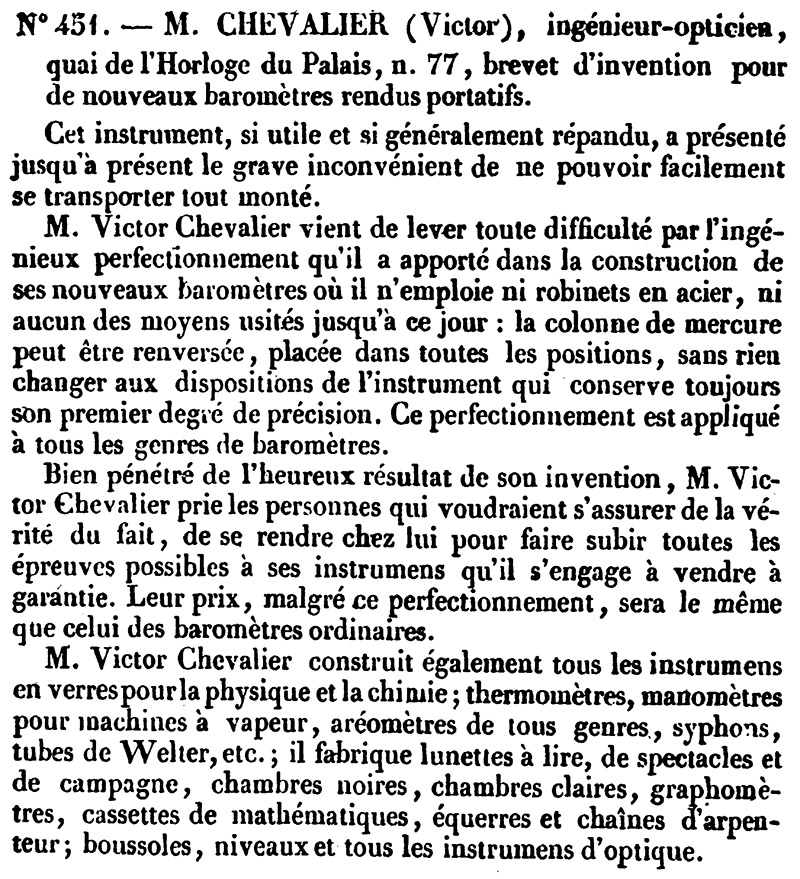
Figure 4.
An 1834 description of Victor Chevalier's portable barometers and other apparatus that he had for sale. Receiving a patent in 1834 implies that he had received considerable experience prior to that date, perhaps in the optical shop of his probably father, Louis Chevalier.
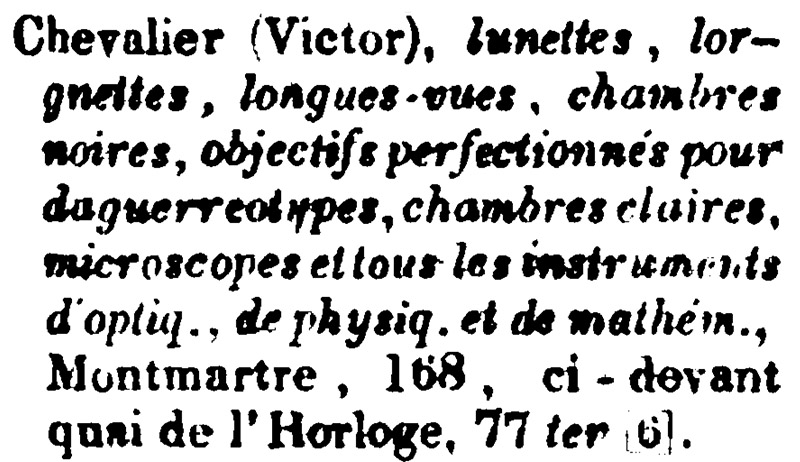
Figure 5.
1846 Paris directory description of Victor Chevalier's business. He noted that he relocated from 77 Quai de l'Horloge to 168 Rue Montmarte.
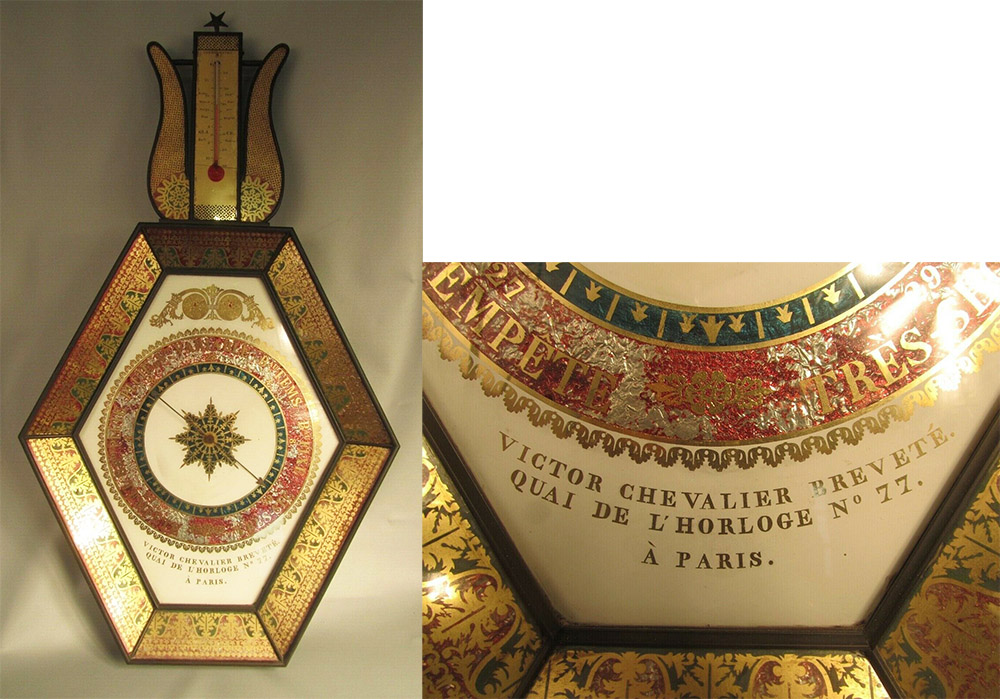
Figure 6.
A barometer that was made by Victor Chevalier. It bears his ca. 1832 - ca. 1844 address of 77 Quai de l'Horloge. Adapted for nonprofit, educational purposes from an internet auction site.
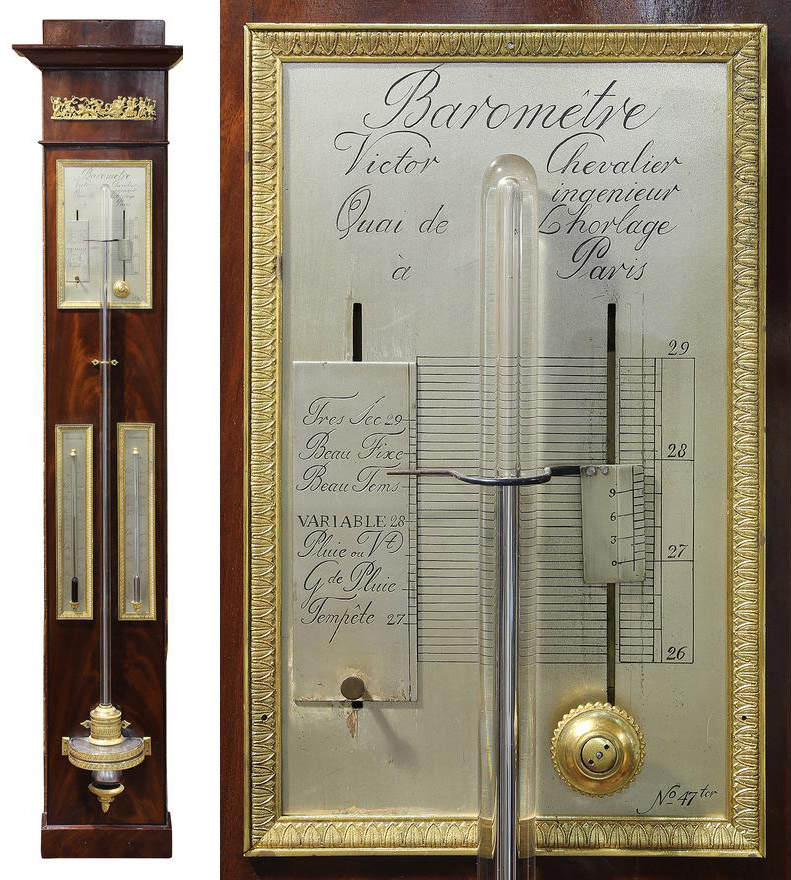
Figure 7.
Another barometer from Victor Chevalier, also with the address Quai de l'Horloge. Adapted for nonprofit, educational purposes from an internet auction site.
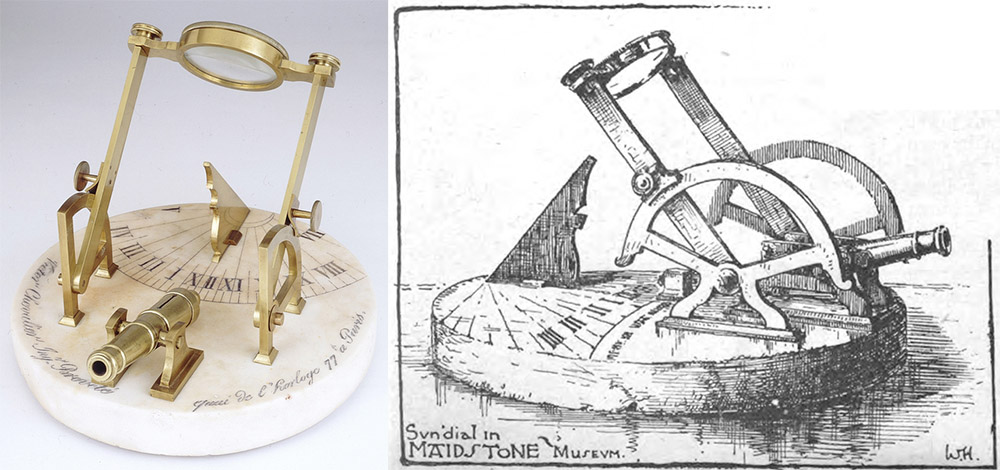
Figure 8.
A sundial/solar canon that was made by Victor Chevalier, when he was at 77 Quai de l'Horloge (ca. 1832 - ca. 1844). The sundial would be positioned such that sunlight at noon was focused onto a fuse in the canon, causing the canon to fire a charge of gunpowder. Adapted for nonprofit, educational purposes from an unattributed image found on the internet and from "The Strand" magazine, 1893.
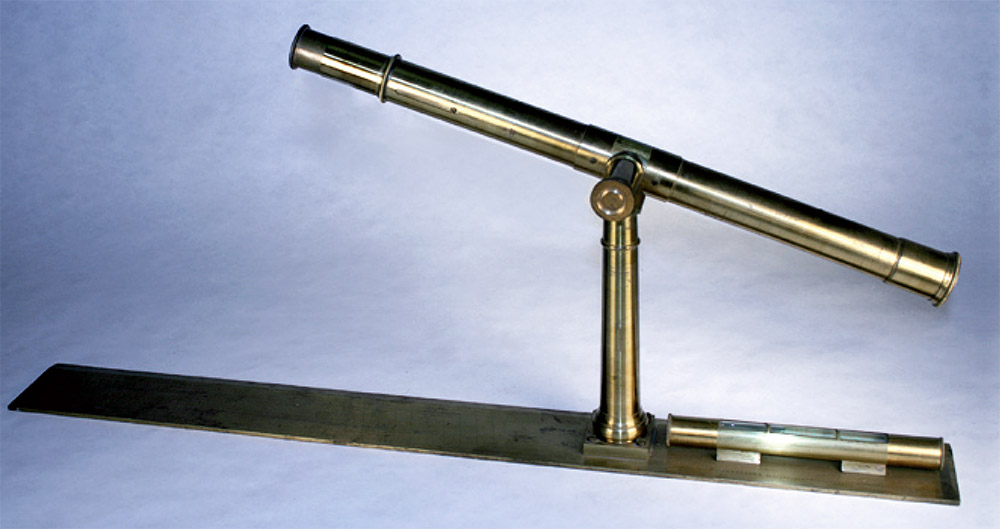
Figure 9.
A clinometer that is signed by Victor Chevalier. It bears the address 168 Rue Montmarte, where he moved in the early 1840s. Adapted for nonprofit, educational purposes from "Instrumentos Topográficos", 2011.
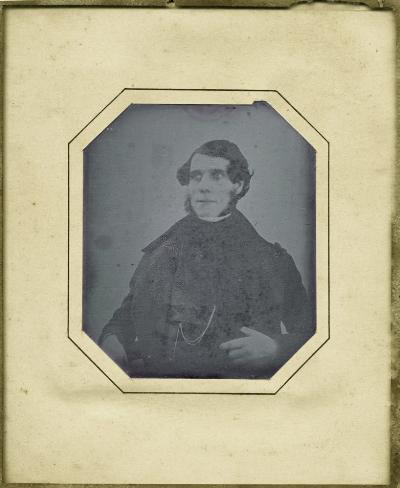
Figure 10.
Circa 1840 daguerreotype photograph of an unknown man. The back holds the trade label that is shown above in Figure 3. Adapted for nonprofit, educational purposes from an internet auction site.
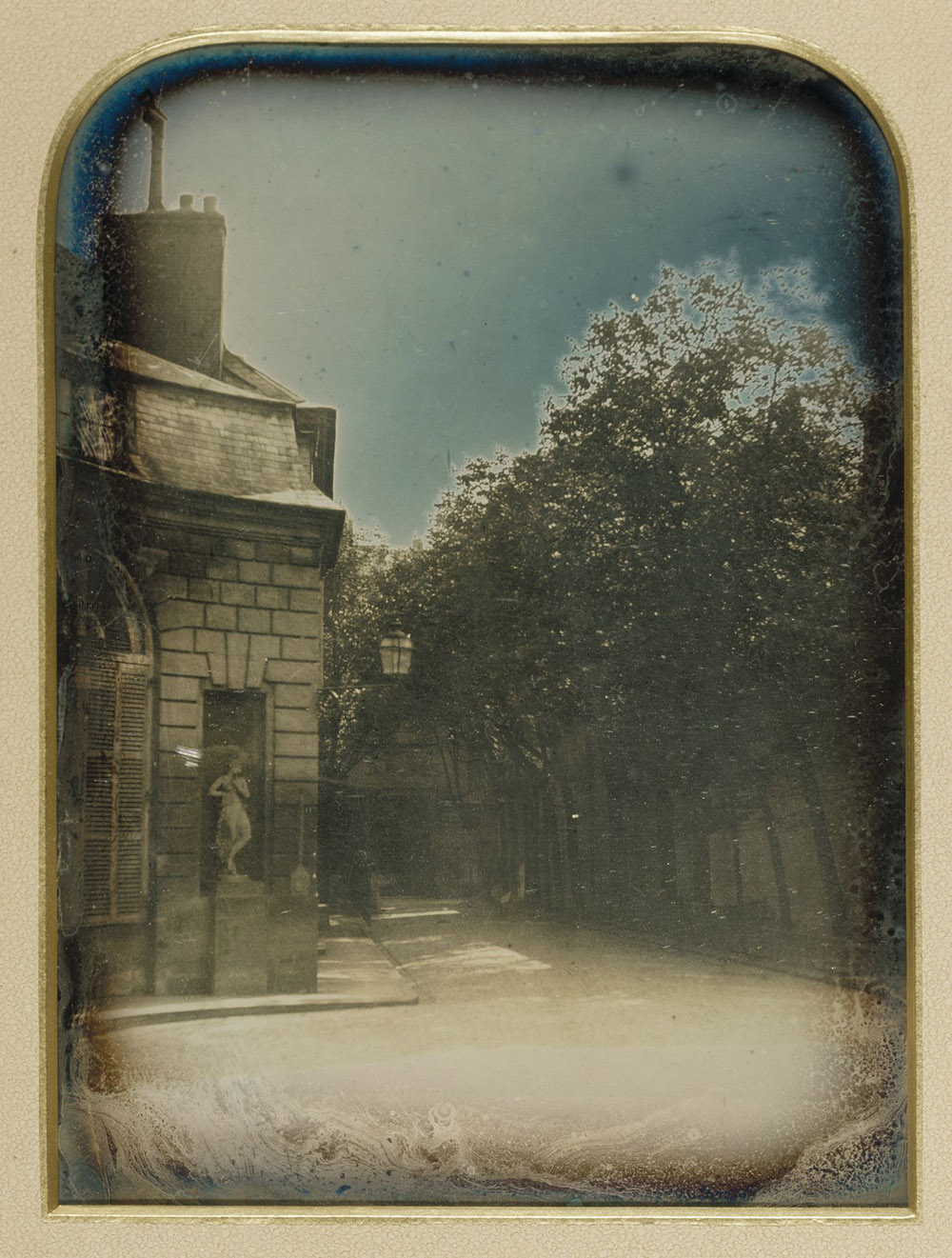
Figure 11.
A ca. 1845 daguerreotype photograph of the courtyard of Hôtel d'Uzès, Paris, labeled on the reverse, "Rue Montmartre, 168., Vor. Chevalier, Ingénieur Opticien, Paris, Vis-à-vis du Passage des Panoramas." This dates from after Victor's move from Quai de l'Hrloge. Adapted for nonprofit, educational purposes from www.cca.qc.ca/fr/recherche/details/collection/object/360190.
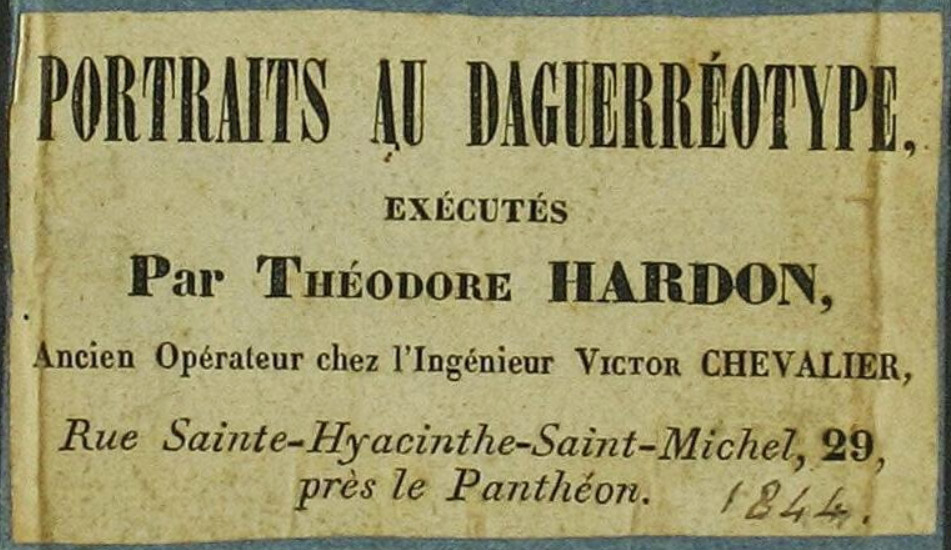
Figure 12.
Trade label of Theodore Hardon, a photographer who was previously employed by Victor Chevalier. Adapted for nonprofit, educational purposes from www.daguerreobase.org/en/type/653adef8-9948-ca92-92c2-ca98a51b4ff9 .
Resources
Almanach du Commerce de Paris (1829) page 82
Almanach du Commerce de Paris (1832) Chevalier (Vor), optician, q. de l'Horloge, 77 ter., page 81
Annuaire Général du Commerce et de l'Industrie (1847) Chevalier (Victor), page 541
Annuaire Général du Commerce et de l'Industrie (1850) Chevalier (Vor), and Chevalier (L.) et fils, page 144
Annuaire Général du Commerce et de l'Industrie (1855) Chevalier (L.) et fils, page 749 (Victor Chevalier was not listed)
Annuaire Général du Commerce et de l'Industrie (1859) Chevalier (L.), page 779 (Victor Chevalier was not listed)
Annuaire Général du Commerce et de l'Industrie (1874) Chevalier (Louis), page 195
Birth record of Louis Victor Chevalier (1812) accessed through ancestry.com
Birth record of Louise Catherine Caroline Martin (1816) accessed through ancestry.com
Birth record of Jeanne Louise Marie Chevalier (1838) accessed through ancestry.com
Bulletin de la Société d'Encouragement pour l'Industrie (1834) Chevalier, L.-V., Vol. 33, page 119
de las Heras Molinos, A.E. (2011) Instrumentos Topográficos, page 181
Death record of Jean Louis Joseph Chevalier (1848) accessed through ancestry.com
Death record of Louise Jeanne Poisson vauve Chevalier (1858) accessed through ancestry.com
Hogg, Warrington (1893) Sundials, The Strand, Vol. 6, pages 308-318
Journal des Connaissances Utiles (1841) Calorifère portatif par M. Victor Chevalier, page 270
Marriage contract of Louis Victor Chevalier and Louise Catherine Caroline Martin (1834) accessed through www.siv.archives-nationales.culture.gouv.fr
Marriage record of Jeanne Louise Marie Chevalier (1863) accessed through ancestry.com
Musée Industriel et Artistique ou Description Complète de l'Exposition des Produits de l'Industrie Française (1844) M. Chevalier (Victor), page 326
Notice des Produits de l'Industrie Française (1834) M. Chevalier (Victor), page 116
Paris government records, accessed through ancestry.com
Rapport du Jury Central sur les Produits de l'Agriculture et de l'Industrie (1849) M. Louis-Victor Chevalier, page 528
Rapport du Jury Central sur les Produits de l'Agriculture et de l'Industrie (1849) MM. Chevalier et fils, page 529
Rapport du Jury Central sur les Produits de l'Industrie Française (1844) M. Chevalier (Victor), page 490